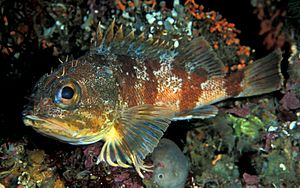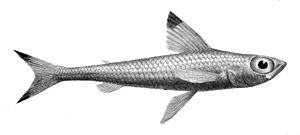Microcotyle neozealanica facts for kids
Quick facts for kids Microcotyle neozealanica |
|
|---|---|
| Scientific classification | |
| Genus: |
Microcotyle
|
| Species: |
neozealanica
|
| Synonyms | |
|
|
Microcotyle neozealanica is a tiny worm that lives on fish. It is a parasite, which means it lives on or inside another animal and gets its food from that animal. This worm lives on the gills of marine (ocean) fish. It belongs to a group of worms called monogeneans and is part of the family Microcotylidae.
Contents
About Its Name
Scientists give every living thing a special two-part name, like a first and last name. This helps everyone know exactly which creature they are talking about.
How Its Name Changed
Microcotyle neozealanica was first discovered and named by scientists Dillon and Hargis in 1965. They first called it Microcotyle neozealanicus. For a while, some scientists thought it belonged to a different group called Paramicrocotyle. But after more study, scientists decided it fits best back into the Microcotyle group. The correct name today is Microcotyle neozealanica. The old name neozealanicus had a small spelling mistake.
What It Looks Like
Microcotyle neozealanica has a long, thin body. Its skin is smooth. The front part of its body holds most of its organs. The back part is called a haptor.
How It Attaches to Fish
The haptor is very important! It has 24 to 29 pairs of special gripping parts called clamps. These clamps are like tiny clips that help the worm hold tightly onto the fish's gills. This way, the worm doesn't get washed away by the water. The clamps are similar in shape but different in size.
Inside Its Body
At the front of its body, the worm has a mouth. Inside its mouth, it has two small suckers. After the mouth, there's a muscular tube called a pharynx. This helps it swallow food. Then, the food goes into its intestine, which has branches that spread out through its body. Each adult worm has both male and female reproductive organs.
Where Its Name Comes From
The second part of its name, neozealanica, tells us something special. It refers to New Zealand. This is because New Zealand is where this type of worm was first found.
Where It Lives and Who Its Hosts Are
This tiny worm lives in the ocean. It is found on the gills of certain marine fish.
Fish Hosts
The main fish this worm lives on is the red gurnard perch, which is scientifically named Helicolenus percoides. This fish belongs to the Sebastidae family. The worm was first discovered on this fish in New Zealand. It has also been found on another fish called Chlorophthalmus nigripinnis, which is now known as Paraulopus nigripinnis (a type of Cucumber fish). This second host fish was found off the coast of Australia.



